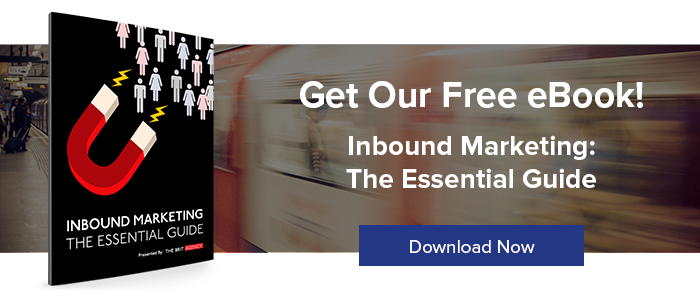Inbound Marketing is here to stay and should by now be at the core of your overall B2B marketing strategy. If you haven't already set your 2017 budget for Inbound Marketing, here are some basic budgeting tips on what to look out for, with the hope that you'll find your 2017 planning process a little easier.
I originally published a shorter version of this blog in September this year, but since then I came across some really interesting CMO research data, recently published by Gartner Group, which has set a better factual backgound for this blog.
As the process of Inbound Marketing becomes more fine-tuned, with better, more predictable results and overall improvements in ROI, we recommend you start by setting clearly defined goals and objectives, working backwards up the funnel. We start with the realistic amount of sales you want, and moving up to the number of opportunities you need, the number of SQL and MQL leads needed, and the total amount of website visitors required to generate the number of leads. Add to this your conversion goals at every conversion stage, and you can start to set some targets. Now onto the budget.
How much does a typical B2B Inbound Marketing plan cost? How much do you need to execute your plan to hit your Inbound Marketing goals? And what should you set your Inbound Marketing budget at?
When it comes to creating an Inbound Marketing budget, keep in mind that you'll truly get what you pay for. If you have a plan in mind, remember your goals too few dollars means you will under-perform.
What we do know, is that the more you financially commit to Inbound Marketing for your business, the more features, tools and content you can use to effectively convert your website traffic into leads, and sales.
The Components of an Inbound Marketing Budget
To help you get a better understanding of B2B Inbound Marketing costs, let’s first take a look at the various elements of Inbound Marketing that can contribute to a total Inbound annual budget.
How much you have to spend influences what you can buy.
If you have a smaller budget, you’ll really need to focus on exactly which tactics will prove most effective and should, therefore, be your priority.
A start-up technology company, for example, must work to capture as much revenue and build as much brand awareness as quickly as possible. Therefore, it should prioritize demand generation tactics like frequent blogging, eBook development, and PPC ads.
Inbound Marketing is a methodology, and as such has a monthly rhythm of repeatable activities, followed by a cycle of campaigns and offers.
There are many components to Inbound Marketing, so here are just a few of the essential elements that can make up a typical Inbound Marketing program that will help you generate more traffic, leads, and sales.
- Weekly/Daily Blogging: It's a fact - the more you blog, the more organic website traffic you will attract. Writing helpful, persona-focused, blog content is an absolute necessity for Inbound Marketing to work. A light weight, or short article, once a month simply isn’t going to cut it. Consistent blogging (weekly/daily 500-word plus, informative blogs) is an essential investment and obviously takes up a lot of time to research, write and post, but has to be a top priority for any company.
- An Active Social Media Program: Social media, such as Facebook, LinkedIn, Google+, Instagram, SlideShare, YouTube, and Twitter, can be the most useful tools in your business’s Inbound Marketing arsenal. For the best Inbound Marketing results, you’re going to have to commit a lot of time and effort into maintaining a consistent, active social media program. But even more challenging and difficult is keeping up with ongoing engagement needs, the constantly changing social media technologies, and how to effectively optimize your content sharing through them.
- Video Content: The use of video, its viewership, and its effectiveness are all growing very fast, and video can leverage the principles of Inbound Marketing very well. Engaging your target persona audiences with high-quality video content can make your business and brand stand out in a sea of competition. That said, making quality Inbound videos that are engaging with CTAs (and hosting this video content) isn’t easy, and it isn’t cheap.
- Premium Content - Such as eBooks, Infographics, White Papers, and Other Valuable Visual Content: Developing premium quality content goes well beyond typical blogging, but premium content is needed for the CTA (Calls-To-Action) conversion process. Using targeted eBooks, infographics, white papers and other forms of premium information can address the varying needs of the buyer journey, as long as they are conversion-oriented, with CTAs that can engage your target persona audience at the right stage of the buyer persona.
- Marketing Platform Integration & Marketing Automation: An essential part of B2B Inbound Marketing is leveraging a marketing automation technology, such as HubSpot, which is standard practice for companies looking to expand and grow. The integrated analytic tools, email marketing, social media, lead management capabilities, along with other technologies (such as website development, CRM and PPC management), provide an invaluable foundation for your Inbound strategy to be successful. That being said, adding marketing automation technology, can contribute an additional $200-$2400 per month to your Inbound Marketing costs.
All of the above are some of essential Inbound Marketing elements, and many more Inbound tactics are available, all of which can add to your total Inbound Marketing costs.
Let's put some numbers out there. An entry level Inbound Marketing program with good blogging frequency, social media, and lead management may scope from $36,000-$48,000 in annual Inbound Marketing costs. If you add to that, Website design, Inbound sales, ongoing graphic design tasks, more frequent blogging, ongoing growth driven design website improvements, deep SEO, PPC ads, ongoing campaign development, and initial strategy and persona buyers journey development - the total marketing spend can quickly add to the overall Inbound Marketing program costs and start to climb to a $10,000 - $20,000 per month program.
Use Your Company Annual Revenue To Determine Your Marketing Budget
For a typical B2B company, an industry standard for setting your marketing budget is to set aside about 10% of your total annual revenue for marketing. So if you are a $5 million company - your annual marketing budget should be around, $500,000 per annum. These numbers do vary from industry-to-industry, so it's worth your while researching what your typical industry budgets are. A trade association for your industry for example, can help you.
According to a recently released 2016 Gartner CMO Spend Survey, marketing budgets continue their steady ascent in 2016, climbing to 12% of company revenue, up from 10% in 2014.
This number isn't typical for every type of business. What about a company in its growth phase vs. a well-established brand? Is 12% really the magic number and if so, what does a 12% investment in marketing get you in ROI?
To balance this data, a 2014 CMO survey published by the American Marketing Association and Duke University, discovered that companies with:
- less than $25 million in revenue spent an average of 11% on marketing
- $25-$99 million in revenue spent an average of 9% on marketing
And these percentages can get lower the larger the corporation.
The study also broke down the typical averages for marketing investment as a percentage of revenue by business type:
- B2B Product Businesses: 10.6%
- B2B Service Businesses: 10.1%
- B2C Product Businesses: 16.3%
- B2C Service Businesses: 10.9%
So while the 2016 Gartner CMO Spend number of 12% may be right for some businesses, it is definitely not a one size fits all figure.
We have to look back to 2013 to find better marketing spend data by industry - The Gartner U.S. Digital Marketing Survey.
- Financial Services / Insurance - 10.6%
- High Tech - 9.1%
- Manufacturing - 10.6%
- Media - 12.7%
- Retail - 10.6%
- Healthcare - 9.2%
(Gartner 2013 - Marketing budget as a percentage of revenue)
How Much Of You Marketing Budget Should Be Spent On Digital?
Once again the 2016 Gartner CMO Spend Survey shows that nearly two-thirds (65%) of marketing leaders plan to increase spending on digital advertising in 2017.
Contributing to the increase are:
- A continuing and consistent shift of offline media spending to digital channels.
- A decline of organic social in favour of paid social.
- The rising importance of video, which is more expensive than other digital techniques for both media and production.
- The use of more marketing technology (such as marketing automation) is also contributing to the increase in the digital marketing spend, and interestingly in the 2016 Gartner report, CMO marketing technology spending is on track to exceed the CIO technology spend in 2017 as the marketing mandate expands to look after a growing number of customer touchpoints.
Here at The Brit Agency, we recommend that you should use about 30-60% (based on business type and growth goals), of your total marketing budget for Inbound Marketing. The remaining 40-70% can be used for trade shows, print ads, community sponsorship, literature development, and other traditional outbound activities. However, as Inbound Marketing becomes more important demonstrating a proven ROI, you will see the Inbound budgets grow because you'll start developing an accountable marketing reporting structure, which at budget time helps you build your case.
The Inbound Marketing budget should be easily justified to the 'C' level team, as the quality of leads you can generate via Inbound Marketing will be better than those generated using traditional Outbound techniques. We also know that the cost-per-lead, via Inbound Marketing is a lot less that the cost-per-lead via Outbound Marketing.
Setting a Marketing Budget Based on Your Growth Goals
Another way of looking at the budget you need for Inbound Marketing can be determined by how much you want to grow your business in the next 12-months.
The more aggressive you want to grow your business, the higher the percentage allocation should be on Inbound Marketing, With some fast growing B2B businesses spending up to 75-90% of their total marketing budget on Inbound by reducing their less measurable, and more expensive outbound activities.
In conclusion, setting a marketing budget is never perfect, so getting the help of an experienced B2B Inbound Marketing agency can help. However, if you take some of the advice we have written about in this blog post, you’re already on your way to creating an Inbound Marketing budget that will prove more effective for your company.
THE BRIT AGENCY is a B2B Inbound Marketing Agency providing Inbound Marketing, Inbound Website Design and Inbound Sales services to companies around the world. We're focused on growing website traffic, qualified leads and sales, using the Inbound lead generation and marketing automation process.
THE BRIT AGENCY is a certified Gold Tier Hubspot Partner, a HubSpot COS certified Inbound Website Design Agency, a Shopify eCommerce Partner, and a certified "Google Badged Agency Partner". We have offices in Toronto and Barrie, Canada, and Salisbury, UK.


